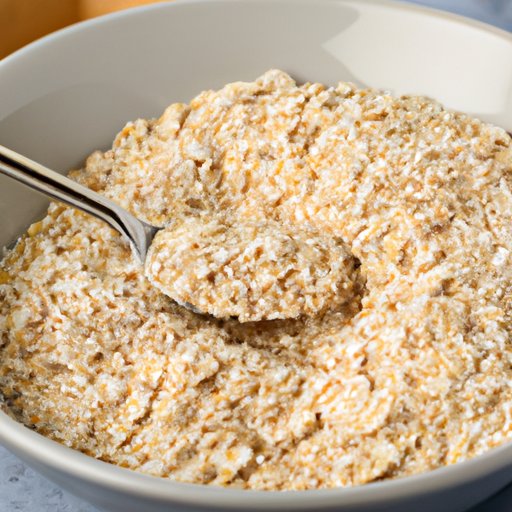
Introduction
Oat bran is a nutritious food that has grown in popularity over the years due to its impressive health benefits. However, many people with gluten sensitivity or celiac disease are unsure if oat bran is safe for them since oats are often cross-contaminated with gluten-containing grains during processing. This article aims to provide a comprehensive guide to oat bran, including its nutritional benefits, gluten-free status, product options, cooking tips, and FAQs.
The Ultimate Guide to Oat Bran: Is it Gluten-Free?
Oat bran is the outer layer of the oat grain that is removed during processing to make oatmeal and oat flour. It is an excellent source of soluble fiber, protein, B-vitamins, minerals, and antioxidants that can support digestive health, lower cholesterol levels, control blood sugar, and promote weight loss.
While oats are naturally gluten-free, they are often contaminated with gluten-containing grains such as wheat, barley, and rye during harvesting, transportation, and processing due to shared equipment, facilities, and fields. This makes oat-based products unsafe for people with gluten intolerance.
However, recent studies have shown that pure, uncontaminated oat bran products are safe for most people with gluten sensitivity or celiac disease to consume in moderate amounts. The North American Society for the Study of Celiac Disease and the European Society for Paediatric Gastroenterology, Hepatology, and Nutrition have declared that pure oats are safe for the majority of celiac patients. However, oats can cause issues for some.
Navigating Gluten-Free Oat Bran Products: What to Look For
There are several types of oat bran products available on the market, including rolled oats, steel-cut oats, oat flour, and oat bran cereal. When shopping for gluten-free oat bran products, it is essential to look for certification from reputable organizations such as the Gluten-Free Certification Organization (GFCO) and the Canadian Celiac Association (CCA). This indicates that the product has been independently tested and verified to contain less than 20 parts per million of gluten, which is considered safe for people with celiac disease.
It is also important to be aware of potential sources of gluten contamination in oat bran production and packaging. Some oat bran products may contain additives or flavorings that contain gluten, or they may be processed in facilities that also handle gluten-containing grains.
Cooking with Oat Bran: Delicious Gluten-Free Recipes to Try
Oat bran is a versatile ingredient that can be used in a wide range of gluten-free recipes, from muffins and pancakes to oatmeal and bread. It adds texture, flavor, and nutrition to your favorite dishes. Here are some delicious recipes to try:
- Oat Bran Muffins
- Gluten-Free Oatmeal Cookies
- Oat Bran Pancakes
- Apple Cinnamon Oat Bran Porridge
- Oat Bran Banana Bread
To incorporate oat bran into your everyday cooking, try adding it to smoothies, yogurt, soups, stews, and casseroles. It can also replace a portion of flour in your baking recipes to boost the fiber content and reduce the amount of gluten.
Oat Bran vs. Other Gluten-Free Grains: Which Is Best?
While oat bran is a nutritious and gluten-free grain option, there are several other gluten-free grains that can offer similar health benefits and versatility in cooking. These include quinoa, brown rice, millet, and amaranth.
Quinoa is a superfood that is rich in protein, fiber, and nutrients and can be used in a variety of savory and sweet dishes, such as salads, grain bowls, and porridge.
Brown rice is a whole grain that is high in fiber, minerals, and antioxidants and can be used in meals such as stir-fries, risotto, and pilaf.
Millet is a small, round grain that is gluten-free, easy to digest, and rich in protein, fiber, and minerals. It can be used in dishes such as porridge, pilaf, and casseroles.
Amaranth is a tiny, ancient grain that is gluten-free, high in protein, and rich in minerals. It can be used in recipes such as porridge, bread, and crackers.
Gluten-Free Oat Bran for Athletes: A Performance-Boosting Superfood?
Oat bran is an excellent food choice for athletes due to its high fiber content, slow-release energy, and muscle-building protein. It can help stabilize blood sugar levels, reduce inflammation, and boost endurance during workouts. Gluten-free oat bran products are especially important for athletes with gluten sensitivity or celiac disease to avoid adverse reactions and ensure optimal performance.
Here are some oat bran-based recipes specifically tailored for athletes:
- Chocolate Oat Bran Protein Bars
- Banana Oat Bran Smoothie
- Blueberry Oat Bran Muffins
- Apple Oat Bran Breakfast Bowl
- Pumpkin Oat Bran Pancakes
FAQs About Oat Bran: Your Gluten-Free Questions Answered
Here are some frequently asked questions about oat bran and gluten:
Is all oat bran gluten-free?
No, not all oat bran products are gluten-free. Some oat bran products may contain gluten from cross-contamination during processing or packaging.
Can I trust products labeled “gluten-free”?
Products labeled “gluten-free” are certified by reputable organizations such as the Gluten-Free Certification Organization (GFCO) and the Canadian Celiac Association (CCA) to contain less than 20 parts per million of gluten, which is considered safe for people with celiac disease.
How do I know if a product contains gluten?
Check the ingredients label for wheat, barley, rye, and oats. Also, look for gluten-free certification from trusted organizations.
How much oat bran should I eat per day?
The recommended daily intake of fiber is 25-30 grams per day for adults. Eating 1/2 to 1 cup of cooked oat bran per day can help you meet this requirement.
Conclusion
Oat bran is a nutritious and versatile grain that can be a valuable addition to a gluten-free diet. While it is important to be aware of potential sources of gluten contamination, certified gluten-free oat bran products are safe for most people with celiac disease or gluten intolerance. Incorporating oat bran into your cooking and baking can add flavor, texture, and nutrition to your favorite dishes. By following the tips and recipes in this guide, you can enjoy the many benefits of gluten-free oat bran.




